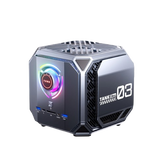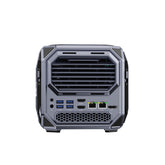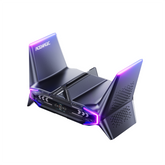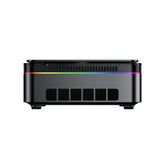How to Choose the Right Mini PC for Your Office Environment?

Modern offices are evolving — they demand compact, quiet, and energy-efficient systems that deliver reliable performance without cluttering the workspace. Mini PCs have become a popular solution, offering desktop-level productivity in a fraction of the size. This guide will help you understand how to choose the right mini PC for your office environment, covering key specifications, performance needs, and setup best practices.
Understanding the Benefits of Mini PCs for Office Work
Mini PCs are not just smaller computers; they represent a more efficient approach to office productivity. Their compact design, reduced power consumption, and silent operation make them a practical choice for both corporate and home offices.
Space-Saving and Aesthetic Workspaces
A mini PC easily fits behind a monitor or under a desk, freeing up valuable workspace and reducing cable clutter. For open or shared offices, this leads to cleaner, more organized desks — a subtle but meaningful boost to productivity and professionalism.
Energy Efficiency and Cost Savings
Mini PCs consume far less power than traditional desktops. For businesses running multiple systems, this translates into measurable energy savings. On average, a mini PC uses about 60–80% less electricity, making it both eco-friendly and cost-effective.
Low Noise and Better Focus
With advanced cooling designs and solid-state storage, mini PCs often operate almost silently. This contributes to a quieter work environment — especially valuable in creative, administrative, or meeting-room settings where focus is essential.
Assessing Your Office Computing Needs
Before purchasing a mini PC, start by identifying what kind of work it needs to handle. This ensures you invest in the right balance of performance and budget.
Identify the Type of Office Tasks
- Basic tasks: email, word processing, video calls, and web browsing.
- Medium workloads: spreadsheet analysis, design applications, multitasking.
- Heavy workloads: coding, photo/video editing, or handling large datasets.
Estimate Performance Requirements
For most offices, a quad-core processor (Intel Core i5 or AMD Ryzen 5) with 16GB of RAM is sufficient. However, for content creation or engineering tools, consider higher-end CPUs and 32GB RAM options.
Tip: Pairing an SSD with at least 512GB capacity ensures fast boot and load times for daily applications.
Key Specifications to Consider Before Buying
Understanding a few core specifications will help you compare models effectively and choose the best mini PC for your office.
CPU and GPU Performance
For typical productivity software, integrated graphics are enough. But if your workflow involves design or simulation, look for mini PCs with dedicated GPUs or high-performance APUs.
Memory and Storage
RAM directly affects multitasking ability. Opt for 16GB if you regularly work across multiple tabs or programs.
Best combination: NVMe SSD for the system drive and SATA SSD for file storage.
Upgrade tip: Choose models that allow easy access to RAM slots and dual-drive setups for future expansion.
Connectivity and Ports
A good office mini PC should include multiple USB ports, HDMI or DisplayPort outputs, and Ethernet.
Port essentials for offices:
- USB-C with DisplayPort Alt Mode for dual 4K monitors.
- Gigabit Ethernet for stable video conferences.
- Front USB-A ports for easy access to peripherals.
Cooling and Noise Management
Some mini PCs are fanless, ideal for silent environments. Others use active cooling for better sustained performance.
| Type | Cooling Method | Noise Level | Best For |
| Fanless | Passive heatsink | Silent | Meeting rooms, admin desks |
| Active | Low-speed fan | Low hum | Designers, developers |
Office tip: Fanless systems offer peace and quiet, while actively cooled units are better for high-load, long-hour usage.
Mini PC vs Traditional Desktop: Which Is Right for Your Office?
Performance Comparison
While desktops still have a slight performance advantage, most mini PCs today can easily handle standard office workloads. Only in specialized fields like 3D rendering or large-scale simulations does the desktop retain a clear edge.
Space and Energy Efficiency
A mini PC’s footprint is typically one-tenth of a traditional desktop, and its energy use can be half or less. This makes it perfect for offices optimizing for sustainability and minimalism.
Total Cost of Ownership
Lower energy consumption and reduced maintenance needs give mini PCs a long-term cost advantage. The trade-off is limited upgrade potential — something most office users can comfortably accept.
💡For a more detailed breakdown of the differences between a mini PC and a traditional desktop—check out our in-depth comparison guide on Mini PC vs Traditional Desktop.
Choosing a Mini PC Based on Office Type
Different offices have different needs — and the ideal configuration varies accordingly.
For Individual Workstations
If you’re a writer, consultant, or manager, choose a system with mid-range performance and dual-monitor support. Quiet operation and compactness should be top priorities.
For Shared or Hybrid Offices
Opt for mini PCs that support remote management, multiple USB-C displays, and quick setup features. These systems can be easily deployed and maintained across flexible seating environments.
For Creative or Technical Teams
Select models with higher TDP CPUs, advanced cooling, and multiple high-speed ports. These ensure smooth operation for design software, code compilation, and heavy multitasking.
Tips for Setting Up Your Mini PC in the Office
Placement and Mounting
Mini PCs can be mounted behind monitors using VESA brackets, placed under desks, or integrated into docking hubs. The goal is to maintain accessibility while minimizing clutter.
Optimizing Performance
Keep system firmware and drivers updated. Enable high-performance power modes in Windows and disable unnecessary startup apps to maximize speed and stability.
Maintenance and Longevity
Regular dust cleaning and firmware updates can extend the device’s lifespan. For SSD-based systems, enabling TRIM support helps maintain storage efficiency over time.
Maintenance reminder: Plan for a minor upgrade or internal cleaning every 2–3 years to keep the system running efficiently.
Recommended Mini PC Configurations
While exact models vary, here’s a reference for different needs:
| User Type | CPU Suggestion | RAM | Storage | Key Features |
| Basic Office | Intel Core i3 / Ryzen 3 | 8GB | 256GB SSD | Quiet, low power |
| Professional | Intel Core i5 / Ryzen 5 | 16GB | 512GB SSD | Dual display, fast Wi-Fi |
| Creative / Developer | Intel Core i7 / Ryzen 7 | 32GB | 1TB SSD | High I/O, advanced cooling |
Buying tips:
- Check for easy RAM and SSD access panels for upgrades.
- Ensure after-sales support or warranty coverage — often overlooked in office purchases.
- Avoid over-spec systems: choose balanced power for cost efficiency.
Conclusion
Choosing the right mini PC for your office environment depends on understanding your workload, performance priorities, and workspace design. Mini PCs deliver an exceptional balance of compactness, efficiency, and versatility — ideal for modern professionals seeking a clean, capable workstation. Take time to evaluate your team’s needs, and you’ll find the perfect system that fits your office and future growth.
| Powerful and Professional |
Efficient and Compact |
Balanced and Versatile |
|---|---|---|
| Intel® Core™ i9-11900H | AMD Ryzen™ 5 7430U | AMD Ryzen™ 7 5700U |
| Intel® UHD Graphics for 11th Gen Intel® Processors | AMD Radeon™ Graphics | AMD Radeon RX Vega 8 |
| Wi-Fi 6E + BT5.2 | Wi-Fi 6 + BT5.2 | Wi-Fi 6 + BT5.2 |
| ACEMAGIC M1 Mini PC | ACEMAGIC K1 Mini PC |
ACEMAGIC AM06 Pro Mini PC |
 |
 |
 |
| Buy Now | Buy Now | Buy Now |
FAQs
1. What are the advantages of using a mini PC in an office environment?
Mini PCs are compact, quiet, and energy-efficient. They offer nearly the same performance as desktops but save desk space and electricity — ideal for modern, minimalist offices.
2. How powerful should a mini PC be for everyday office work?
For general productivity tasks, a Core i5 or Ryzen 5 processor with 16GB RAM is sufficient. Heavier workloads like video editing or coding benefit from higher-tier CPUs and more memory.
3. Can mini PCs handle multitasking and dual monitors?
Yes. Most modern mini PCs support dual-monitor setups via HDMI and USB-C. With adequate RAM, they manage multitasking across multiple apps efficiently.
4. Are mini PCs reliable for long-term office use?
Absolutely. High-quality mini PCs feature durable components, SSD storage, and efficient thermal design. Regular updates and maintenance help ensure years of stable performance.
5. What’s the difference between a mini PC and a desktop for office work?
Desktops offer more upgrade options, while mini PCs emphasize compactness and low power consumption. For most business use cases, a mini PC provides all necessary performance.
6. Do mini PCs support upgrades like RAM or SSD?
Many models allow RAM and SSD upgrades. However, always check the product’s specifications before purchase, as some compact designs have fixed components.
7. Is it better to buy a pre-built mini PC or customize one for office needs?
Pre-built options save time and ensure compatibility, while custom builds offer more flexibility. For office deployment, pre-configured models are often the more practical choice.
8. How can I maintain and optimize my mini PC’s performance over time?
Keep your operating system updated, clean the vents regularly, and monitor storage health. Simple routine maintenance ensures consistent speed and longevity.







Leave a comment
Please note, comments need to be approved before they are published.